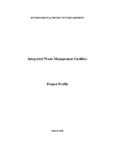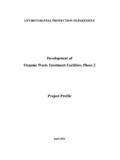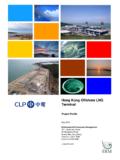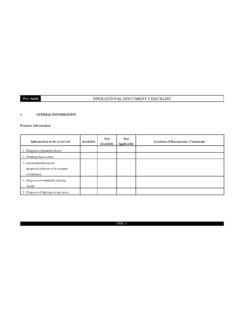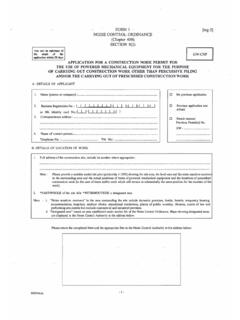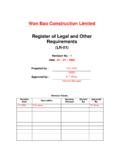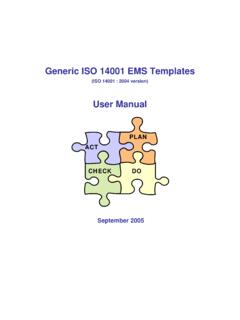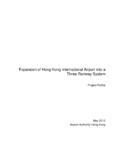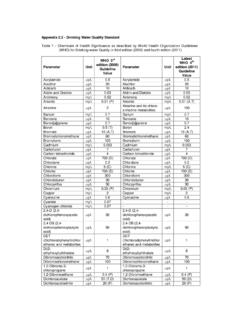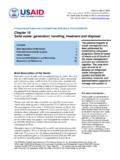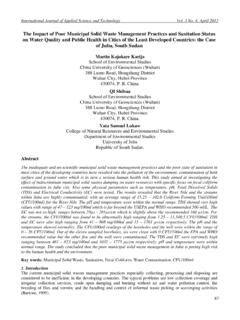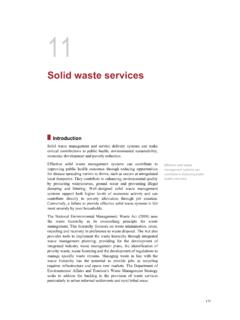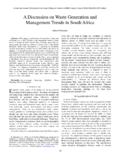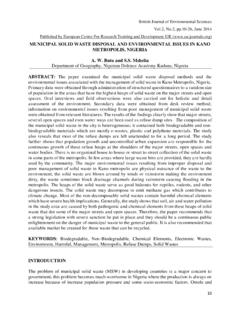Transcription of Section6-Waste Management 27 July 01
1 Kowloon Development OfficeTerritory Development Department, Hong Kong Agreement No. CE32/99 Comprehensive Feasibility Study for the Revised Scheme ofSouth East Kowloon Development22936-REP-0057-02 Environmental Monitoring and Audit ManualPage 6-3 Ove Arup & Partners Hong Kong LtdJuly 2001system in Public Works Programme (PWP) contracts for the proper disposal of C&D materialat public filling facilities or The Works Bureau Technical Circular No. 25/99 Incorporation of Information onConstruction and Demolition Material Management in Public Works Subcommittee Paperspromulgates the policy and guidelines for incorporating information on the Management ofconstruction and demolition material in Publics Works Subcommittee papers recommendingthe upgrading of projects to Category A of the Public Works Programme for theimplementation of construction The Works Bureau Technical Circular No.
2 12/2000 Fill Management sets out the terms ofreference and membership composition of the Marine Fill Committee and Public FillCommittee which shall take up the functions and responsibilities of the Fill ManagementCommittee established in June 1989. It also explains how fill resources, construction anddemolition material (C&DM), and dredged/excavated sediment disposal are The Works Bureau Technical Circular No. 29/2000 - waste Management Plan introduces therequirement for contractors to prepare and implement a waste Management plan (WMP).
3 Therequirement shall be included in all PWP contracts (including design and build contracts butexcluding term contracts and contracts administered by Electrical and Mechanical ServicesDepartment). waste Management The Contractor is responsible for waste control within the construction site; removal of thewaste material produced from the site; and to implement any mitigation measures to minimisewaste or redress problems arising from the waste from the site. The waste material mayinclude any sewage, waste water or effluent containing sand, cement, silt or any othersuspended or dissolved material to flow from the site onto any adjoining land, storm sewer,sanitary sewer, or any waste matter or refuse to be deposited anywhere within the site or ontoany adjoining A proper waste Management plan should be implemented to promote waste minimisation atsource.
4 Where waste generation is unavoidable then the potential for recycling or reuse shouldbe explored and opportunities taken. If wastes cannot be recycled then the recommendeddisposal routes should be Different types of construction waste generated from the site should be segregated, stored,transported and disposed of separately in accordance with EPD s required procedures. It isimportant that the sorting of wastes should be done on-site. All waste materials should besegregated into categories covering: excavated material or construction waste suitable for reuse on-site; excavated material or construction waste suitable for SEKD reclamation of public fillingareas; remaining waste for landfill; chemical waste .
5 And general On site measures promoting proper segregation and disposal of construction waste should beimplemented, provide separate containers for inert (rubber, sand, stone etc) and non-inert(wood, organics etc) wastes. The inert waste can be taken to public filling area and the non-inert waste can be transported to strategic Development OfficeTerritory Development Department, Hong Kong Agreement No. CE32/99 Comprehensive Feasibility Study for the Revised Scheme ofSouth East Kowloon Development22936-REP-0057-02 Environmental Monitoring and Audit ManualPage 6-4 Ove Arup & Partners Hong Kong LtdJuly It will be the Contractors' responsibility to dispose of excavated spoil and construction Contractors should make use of excavated spoil as much as possible to minimise off-sitefill material requirements and disposal of spoil.
6 During road transportation of excavated spoil,vehicles should be covered to avoid dust The Contractor should also pay attention to the waste Disposal Ordinance, the Dumping atSea Ordinance, the Public Health and Municipal Services Ordinance and the Water PollutionControl Ordinance, and carry out the appropriate waste Management work. The relevantlicence/permit, such as the effluent discharge licence, the chemical waste producerregistration, etc. should be obtained.
7 The Contractor should refer to the relevant bookletsissued by EPD when applying for the During the site inspections and the document review procedures as mentioned in Sections of this Manual, the EAT Leader should pay special attention to the issues relating towaste Management , and check whether the Contractor has followed the relevant contractspecifications and the procedures specified under the laws of Hong Kong, as well as thelegislation and guidelines described in Section On the Management of construction and demolition (C&D) materials, reference should bemade to Work Bureau Technical Circulars WBTC 29/2000 on waste Management Plan.
8 Inaddition, the EM&A report should regularly publish information on Management of C&Dmaterials to ensure that information included in the Environment section of the PWSC paperare monitored and audited during the construction stage. The inert C&D materials should alsobe reused within the project as far as possible instead of disposing of at public filling Construction and Demolition (C&D) Components of C&D wastes such as steel and other metals should be segregated and recycledas far as possible before disposal to Wastes such as concrete and rubble should only be disposed of at a public filling An on-site construction and demolition waste handling facilities including temporary bargingpoint and areas for sorting and stockpiling of all C&D waste should be set up for handling thelarge quantities of C&D waste generated prior to disposal.
9 Which is in reference to the WorksBureau Technical Circular No. 5/98 On Site Sorting of Construction waste on If there is surplus waste required to be disposed of at public filling area, it should be noted thatthe public filling materials should only consist of earth, building debris and broken rock andconcrete. They should be free from marine mud, household refuse, plastic, metals, industrialand chemical waste , animal and vegetable matter, and other material considered unsuitable bythe public filling Supervisor.
10 Small quantity of timber mixed with otherwise suitable materialwill be Chemical Chemical waste ( oily sludge, halogenated solvent) produced from decommissioning ofunderground pipes and tanks and other activity should be handled according to the Code ofPractice on the Packaging, Labeling and Storage of Chemical waste and disposed of by alicensed contractor at Tsing Yi Chemical waste Treatment Uncontrolled disposal of chemical and hazardous waste into the air, soil and waters should Development OfficeTerritory Development Department, Hong Kong Agreement No.
